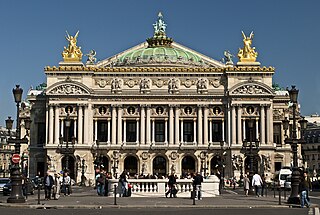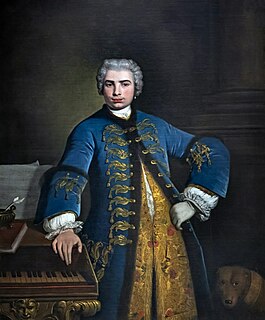
Opera is a form of theatre in which music is a fundamental component and dramatic roles are taken by singers, but is distinct from musical theatre. Such a "work" is typically a collaboration between a composer and a librettist and incorporates a number of the performing arts, such as acting, scenery, costume, and sometimes dance or ballet. The performance is typically given in an opera house, accompanied by an orchestra or smaller musical ensemble, which since the early 19th century has been led by a conductor.

Rhetoric is the art of persuasion, which along with grammar and logic, is one of the three ancient arts of discourse. Rhetoric aims to study the techniques writers or speakers utilize to inform, persuade, or motivate particular audiences in specific situations. Aristotle defines rhetoric as "the faculty of observing in any given case the available means of persuasion" and since mastery of the art was necessary for victory in a case at law, for passage of proposals in the assembly, or for fame as a speaker in civic ceremonies; he calls it "a combination of the science of logic and of the ethical branch of politics". Rhetoric typically provides heuristics for understanding, discovering, and developing arguments for particular situations, such as Aristotle's three persuasive audience appeals: logos, pathos, and ethos. The five canons of rhetoric or phases of developing a persuasive speech were first codified in classical Rome: invention, arrangement, style, memory, and delivery.

Josquin des Prez, born Josquin Lebloitte, often referred to simply as Josquin, was a French composer of the Renaissance. He was the most famous European composer between Guillaume Dufay and Giovanni Pierluigi da Palestrina, and is usually considered to be the central figure of the Franco-Flemish School. Josquin is widely considered the first master of the high Renaissance style of polyphonic vocal music that was emerging during his lifetime.

In opera, verismo was a post-Romantic operatic tradition associated with Italian composers such as Pietro Mascagni, Ruggero Leoncavallo, Umberto Giordano, Francesco Cilea and Giacomo Puccini. Verismo as an operatic genre had its origins in an Italian literary movement of the same name. This was in turn related to the international literary movement of naturalism as practised by Émile Zola and others. Like naturalism, the verismo literary movement sought to portray the world with greater realism. In so doing, Italian verismo authors such as Giovanni Verga wrote about subject matter, such as the lives of the poor, that had not generally been seen as a fit subject for literature.

Adrian Willaert was a Netherlandish composer of the Renaissance and founder of the Venetian School. He was one of the most representative members of the generation of northern composers who moved to Italy and transplanted the polyphonic Franco-Flemish style there.
A chanson is generally any lyric-driven French song, though it most often refers to the polyphonic French song of late medieval and Renaissance music. The genre had origins in the monophonic songs of troubadours and trouvères, though the only polyphonic precedents were 16 works by Adam de la Halle and one by Jehan de Lescurel. Not until the ars nova composer Guillaume de Machaut did any composer write a significant amount of polyphonic chansons.

Coloratura is an elaborate melody with runs, trills, wide leaps, or similar virtuoso-like material, or a passage of such music. Operatic roles in which such music plays a prominent part, and singers of these roles, are also called coloratura. Its instrumental equivalent is ornamentation.
Musica ficta was a term used in European music theory from the late 12th century to about 1600 to describe pitches, whether notated or added at the time of performance, that lie outside the system of musica recta or musica vera as defined by the hexachord system of Guido of Arezzo.
Bel canto —with several similar constructions —is a term with several meanings that relate to Italian singing.
Sir John Huxtable Elliott is an English historian, Regius Professor Emeritus at the University of Oxford and Honorary Fellow of Oriel College, Oxford, and Trinity College, Cambridge. He publishes under the name J. H. Elliott.
Messa di voce[ˈmessa di ˈvoːtʃe] is a singing technique that requires sustaining a single pitch while gradually making the voice louder (crescendo) and then softer (diminuendo). It is considered to be a particularly advanced test of singing ability.
Edward Zambara was a Canadian-American bass-baritone singer and leading music educator.
Chest voice is a term used within vocal music. The use of this term varies widely within vocal pedagogical circles and there is currently no one consistent opinion among vocal music professionals in regard to this term. Chest voice can be used in relation to the following:

The Missa de Beata Virgine is a musical setting of the Ordinary of the Mass, by Renaissance composer Josquin des Prez. A late work, probably composed or assembled around 1510, it was the most popular of his masses in the 16th century.
A voice type is a group of voices with similar vocal ranges, capable of singing in a similar tessitura, and with similar vocal transition points (passaggi). Voice classification is most strongly associated with European classical music, though it, and the terms it utilizes, are used in other styles of music as well.

Cornelius Lawrence Reid, was a well-known vocal pedagogue in New York City, specialist in the bel canto technique, and author of books on bel canto.

Giacomo David, was a leading Italian tenor of the late 18th and early 19th centuries.
David Parry is an English conductor who is particularly known for his work in opera. Described as "a man of the theatre with whom directors love to work; he is good with singers; he knows the British opera world like the back of his hand. He is a controversial and outspoken defender of the operatic form, and a passionate advocate of opera in English", his work includes a large discography of complete opera recordings of rarely performed works made on the Opera Rara and Chandos record labels, as well as works recorded with well-known British and European orchestras. Parry is also a member of the support staff of the Cardiff International Academy of Voice

Thomas Mace was an English lutenist, viol player, singer, composer and musical theorist of the Baroque era. His book Musick's Monument (1676) provides a valuable description of 17th century musical practice.

Music in early modern Scotland includes all forms of musical production in Scotland between the early sixteenth century and the mid-eighteenth century. In this period the court followed the European trend for instrumental accompaniment and playing. Scottish monarchs of the sixteenth century were patrons of religious and secular music, and some were accomplished musicians. In the sixteenth century the playing of a musical instrument and singing became an expected accomplishment of noble men and women. The departure of James VI to rule in London at the Union of Crowns in 1603, meant that the Chapel Royal, Stirling Castle largely fell into disrepair and the major source of patronage was removed from the country. Important composers of the early sixteenth century included Robert Carver and David Peebles. The Lutheranism of the early Reformation was sympathetic to the incorporation of Catholic musical traditions and vernacular songs into worship, exemplified by The Gude and Godlie Ballatis (1567). However, the Calvinism that came to dominate Scottish Protestantism led to the closure of song schools, disbanding of choirs, removal of organs and the destruction of music books and manuscripts. An emphasis was placed on the Psalms, resulting in the production of a series of Psalters and the creation of a tradition of unaccompanied singing.










